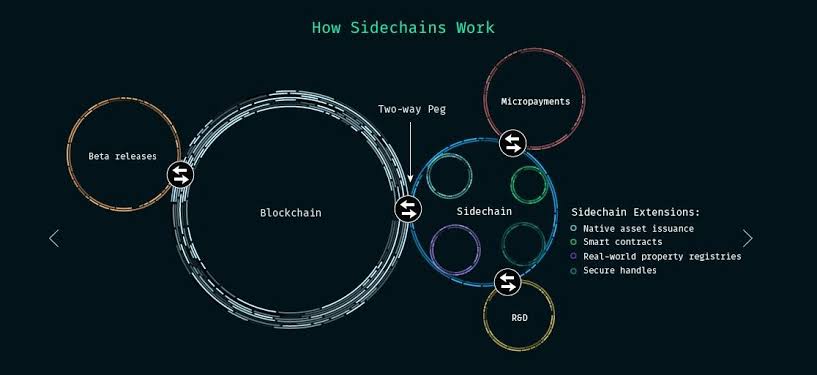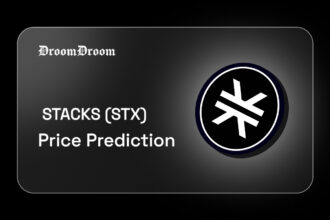You may have sometimes wondered how different blockchains can communicate with each other. Or how some Blockchains can have faster and cheaper transactions than others? If so, then you might be interested in learning about sidechains.
In this comprehensive guide, we will explain everything you need to know about sidechains, from the basics to the advanced. You will discover how sidechains can enhance and expand the capabilities and possibilities of Blockchains–basically how sidechains work, why they are useful, what are some examples, their benefits, and the drawbacks of using sidechains.
Sidechains are separate Blockchains that are connected to another blockchain, called the parent chain. They allow users to transfer their assets between the mainchain and the sidechain, and vice versa and benefit from the features and advantages of both chains. Sidechains can offer faster and cheaper transactions, different consensus algorithms, and much more.
To begin with, do you know what a Blockchain is? In simple words, a blockchain is like a big book that records all the transactions that happen on a network. For example, the Bitcoin blockchain records all the transfers of bitcoins between different people. A blockchain is a very secure and transparent way to transact, and this is unarguably so because everyone can see what is written on it, and no one can change it without the agreement of the majority.
But sometimes, a blockchain can have some problems. For example, it can be slow, expensive, or limited in what it can do. Imagine if you want to buy a pizza with Bitcoins, but you have to wait for an hour and pay a high fee for your transaction to be confirmed. Or imagine if you want to use your Bitcoins for some smart contracts or games, but the Bitcoin blockchain does not support them. That would be very frustrating, right?
This is where sidechains come in. Sidechains are like smaller books that are connected to the big book (the Blockchain), or the mainchain. Sidechains allow you to move your assets, maybe Bitcoins or ETH or SOL, from the mainchain to the sidechain, and back. This way, you can enjoy the benefits of both books, without affecting the security and stability of the mainchain.
To further illustrate what’s happening here and bring it home, let’s say you have some Bitcoins (I’m sure you know why we’re using BTC, by now?), on the Bitcoin mainchain, but you want to use them for some smart contracts or games that are only available on the Ethereum mainchain. You could use a sidechain that is compatible with both Bitcoin and Ethereum, an example is Rootstock (RSK), to move your bitcoins to the sidechain, and then use them as if they were ether (ETH) on the Ethereum mainchain. When you are done, you can move your Bitcoins back to the Bitcoin mainchain, using the same sidechain. It’s that simple.
How Sidechains Work?
Let’s wade a little deeper into the ‘mechanism of operation’ of sidechains. Sidechains work by using a special process called a two-way peg. What’s this? Look at a two-way peg like a bridge that connects the mainchain and the sidechain. It makes sure that the amount of assets on both chains is always the same, and that no one can cheat or create new assets out of nothing, or otherwise, spend the assets transferred twice.
To use a sidechain, you need to send your assets to a special address or a smart contract on the mainchain, which acts as a gateway to the sidechain. This will lock your assets on the mainchain and tell the sidechain that you have transferred them. Then, the sidechain will check the transfer and create the same amount of assets on the sidechain for you to use. You can then freely move and spend your assets on the sidechain, as long as you follow the rules and protocols of the sidechain.

When you want to move your assets back to the mainchain, all you need is to send them to another special address or a smart contract on the sidechain, which acts as a gateway to the mainchain. This will destroy your assets on the sidechain and tell the mainchain that you have transferred them back. Then, the mainchain will check the transfer and unlock the same amount of assets on the mainchain for you to use. You can then freely move and spend your assets on the mainchain, as long as you follow the rules and protocols of the mainchain of that blockchain.
This is why we say sidechains are similar to two-way traffic or double parallel roads. Thus, you can move assets to and fro between the sidechains and a mainchain of your choice, provided the rules and protocols of both chains are met and kept to the latter.
Why Are Sidechains Useful?
Sidechains are useful because they can offer different features and advantages that the mainchain may not have, or may have at a higher cost or lower speed. Whichever is the case, different conditions can necessitate the use or usefulness of the sidechains to a specific user. For example, some sidechains can have:
Faster And Cheaper Transactions
Some sidechains can process more transactions per second and charge lower fees than the mainchain, making them more suitable for frequent and small payments, or for applications that require high scalability and performance. Take, for instance, the Lightning Network, which is a Bitcoin sidechain that enables instant and low-cost transfers of bitcoins and other assets, using a network of payment channels.
Different Consensus Algorithms
Some sidechains can use different ways of reaching an agreement and securing the network than the mainchain. This makes them more efficient, flexible, or adaptable to different use cases or environments. The Loom Network, as an example is an Ethereum sidechain that uses a delegated proof-of-stake (DPoS) algorithm, which allows users to elect validators who produce blocks and earn rewards, instead of using the proof-of-work (PoW) algorithm, which requires miners to solve complex puzzles and consume a lot of energy and waste user’s precious time.
New Functionalities And Innovations
Lastly, different sidechains can support new types of transactions, smart contracts, games, or other features that the mainchain may not have, or may have difficulty implementing, thus positioning them as more attractive for developers and users who want to experiment and innovate. The Axie Infinity is a vandid example of a game that runs on a sidechain called Ronin, which is connected to the Ethereum mainchain. It allows users to collect, breed, and battle cute creatures called Axies, and earn tokens and rewards.
A couple of other reasons why users may find a particular sidechain useful exist, but as already pre-established, they are mostly user or developer-dependent factors or preferences.
What Are Some Examples of Sidechains?
There are many examples of sidechains that exist or are being developed for different purposes and platforms. Albeit, all sidechains fall into two basic categories or types. These are, one, those with two independent blockchains, and, two, those where one blockchain is dependent on the other (i.e. the parent chain and the ‘child’ or dependent chain).
Generally, here are some of the most popular and notable ones:
Liquid Network
This is a Bitcoin sidechain that enables fast and confidential transfers of Bitcoin and other assets, as well as the issuance of new tokens and stablecoins. Liquid Network also supports atomic swaps, which are cross-chain exchanges of assets without any intermediaries.
Polygon
Polygon is a known Ethereum sidechain that provides a framework for building and connecting scalable and secure blockchain networks. It supports various types of sidechains, e.g. Plasma, zkRollups, Optimistic Rollups, and Validium, which use different techniques to achieve high throughput and low fees.
Binance Smart Chain
An example of a sidechain that runs parallel to the Binance Chain, which is the mainchain of the Binance ecosystem, is the Binance Smart Chain. It enables smart contracts, games, and interoperability with other blockchains, while at the same time, leveraging the fast and low-cost transactions of the Binance Chain.
SmartBCH
SmartBCH is a kind of sidechain that connects two separate blockchains. It is a sidechain for Bitcoin Cash that can run smart contracts and dApps like Ethereum. It has a special bridge called SHA-Gate to move Bitcoin Cash between the two chains. When you send Bitcoin Cash from the mainchain to the sidechain, you use the normal Bitcoin Cash software. When you send Bitcoin Cash from the sidechain to the mainchain, you use a group of trusted nodes that operate the bridge and a group of miners that check the bridge. It’s fast and interoperably efficient.
P.S. SmartBCH does not have its coin but uses Bitcoin Cash instead.
xDai
This is another user-friendly sidechain that is compatible with Ethereum and uses a stablecoin called xDai as its native currency. It aims to provide a fast and cheap way to transfer and use stablecoins for everyday transactions and applications.
Polkadot
Polkadot platform that connects multiple Blockchains, called parachains, to a mainchain, called the relay chain. It allows different Blockchains to communicate and share security, scalability, and innovation.
Cosmos
Cosmos is a platform that connects multiple blockchains, called ‘Zones’, to a mainchain, called the ‘Hub’. It allows different blockchains to communicate and exchange assets, using a standard protocol called inter-blockchain communication (IBC).
Drawbacks And Risks of Sidechains?
Sidechains are not perfect solutions, as they come with some challenges and risks that users and developers should be aware of. Below are some of the main ones, with anecdotal understanding:
Security And Trust
Sidechains are not as secure as the mainchain, because they rely on their consensus mechanisms and validators, which may be less decentralized, robust, or trustworthy than the mainchain. This means that sidechains are more vulnerable to attacks, hacks, or failures, which could result in the loss or theft of assets. A most recent example of a sidechain hack is the Poly Network cross-chain bridge exploit on July 2nd, 2023, which has 57 different crypto assets across 10 Blockchains. Although Poly Network did not report the exact amount stolen, reports had it that it was over $5 million worth of assets from various sidechains.
Compatibility And Interoperability
Sidechains are not always compatible or interoperable with the mainchain or other sidechains, because they may use different standards, protocols, or formats. By implication, sidechains may face difficulties or limitations in transferring or exchanging assets, data, or functionality across different chains. The lack of a common standard or protocol for cross-chain communication and asset transfer among different sidechains and layer 2 solutions remains a serious challenge to users.
User Experience And Adoption
Let’s face the facts, using or accessing sidechains may not be simple or convenient, because they may demand extra steps, tools, or knowledge from the users or developers. This implies that sidechains may offer a lower user experience or adoption than the mainchain or other platforms. A more relevant example of a user experience and adoption challenge is the difficulty and confusion of handling multiple wallets, keys, and addresses for different sidechains and layer 2 solutions.
Regulation And Compliance
Another disadvantage of using sidechains is that they sometimes have legal or compliant issues, with the laws and regulations of different countries or regions, because they may enable activities or features that are prohibited or restricted by the authorities. To lay it out, sidechains may face legal challenges or sanctions from governments or regulators, which could affect their operations or users. The crackdown on cryptocurrency mining and trading by the Chinese government, which has affected the security and stability of some sidechains that rely on Chinese miners or validators is one such instance.
Competition And Innovation
Finally, in terms of stepping up the game and staying atop, sidechains are not always the best or the only solutions for improving or expanding the capabilities and possibilities of Blockchains. Because, realistically, there may be other technologies or platforms that offer better or alternative solutions. Sidechains, therefore, face competition or obsolescence from the innovations or developments of other players in the blockchain space. In September 2022, the Ethereum mainchain upgraded to the Ethereum 2.0 version, which introduced a new consensus algorithm called proof-of-stake (PoS), which is faster, cheaper, and more environmentally friendly than the previous proof-of-work (PoW) algorithm. This made many sidechains that use PoW or other algorithms less competitive or relevant.
Conclusion
Sidechains are an exciting and promising technology that can enhance and expand the capabilities and possibilities of Blockchains. They can offer faster and cheaper transactions, different consensus algorithms, new functionalities and innovations, and more. However, they also have some challenges and risks, such as security and trust, compatibility and interoperability, user experience and adoption, regulation and compliance, competition and innovation, and more. Therefore, users and developers should carefully weigh the pros and cons of using sidechains and always do their own research and due diligence before engaging with them.




















